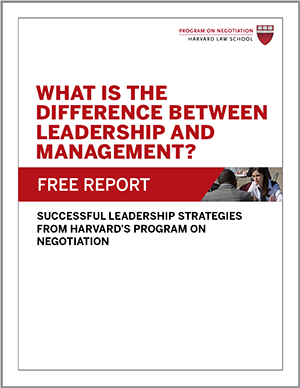
Today more than ever, employees want a say in the decisions that affect them. Workers are increasingly demanding input into where and when they work, what they do, whom they work with, and other issues. Democratic leadership styles, such as collective leadership and participative leadership, may prove to be particularly suited to improving job satisfaction and retention.
What is participative leadership? We take a closer look at the ins and outs, and pros and cons, of the participative leadership style.
What Is Participative Leadership?
Participative leadership is a type of democratic leadership style in which subordinates are intentionally involved in organizational decision making. Goals of participative leadership include enhancing employees’ sense of ownership of their work, improving overall decision making, and integrating workers’ personal goals with those of the organization, write Qiang Wang, Hong Hou, and Zhibin Li in a 2022 review of participative leadership for Frontiers in Psychology.
Participative leadership dates back to primitive, nomadic, small hunger-gatherer societies. Hierarchical leadership became more common in large-scale agricultural societies, as coordinating group decision making became more difficult.
In 1961, American social psychologist Rensis Likert formally presented the concept of participative leadership in the modern workplace. He outlined three main principles of participative leadership theory: 1) the principle of mutual support, which specifies that leaders and employees have the trust and confidence in one another needed to jointly determine and pursue goals; 2) the group decision principle, or a commitment to group decision making; and 3) the high standards principle, which fosters collective responsibility for achieving excellence.
In 1997, Surinder Kahai and colleagues defined participative leadership style as one in which leaders ask for employee input before making decisions, delegate some decision-making power to subordinates, and/or encourage joint decision making. As this definition suggests, the amount of decision-making authority given to employees in participative leadership can vary. In general, leaders who espouse a participative leadership style aim to reach decisions through democratic consultation with employees, such as voting and consensus building; leaders are ultimately free to make final decisions.
Participative leadership is often contrasted with directive leadership, a more top-down leadership style in which leaders assign employees specific work tasks and expectations, and retain control over significant decisions.
Research on Participative Leadership
What determines whether a leader or organization adopts a participative leadership style? Wang, Hou, and Li review numerous individual and organizational influences identified by researchers. Experienced leaders, as compared to newer and younger leaders, may be more inclined to engage in participative leadership. Leaders who rate high on self-awareness also gravitate toward participative leadership, research shows. Moreover, the more similar leaders and followers are to each other, the more likely they seem to be to engage in participative leadership.
How Participative Leadership Affects Employees
The results of numerous studies show participative leadership generally benefits employees’ psychological well-being, increases their organizational commitment, and makes them more trusting of their leaders, according to Wang, Hou, and Li.
When employees help make organizational decisions, they become more invested in them. Consequently, they feel more motivated to remain with the organization to ensure sure their goals are met, writes Corey S. Halaychik in the book Lessons in Library Leadership. Employees are also more likely to accept rather than resist changes to policies they helped craft. “Providing an opportunity for followers to help shape the future creates a strong sense of buy-in,” writes Halaychik.
Participative leadership enhances employees’ sense of self-efficacy and psychological security, which translates into greater innovation and performance, research finds. However, by increasing the challenges and responsibilities that employees face, participative leadership can increase employee stress. Leaders need to ensure employees’ workload doesn’t become overly burdensome as a result of decision-making demands.
How Participative Leadership Affects Organizations
Most scholarly research concludes that participative leadership significantly improves organizational performance and innovation. In comparison to directive leadership, participative leadership improves creativity but reduces efficiency. This is not surprising, given the greater number of people involved in decision making under participative leadership and thus the greater need for deliberation and coordination.
Participative leadership is “time intensive,” says Halaychik. It requires leaders to devote significant time to explaining possible options so that followers are equipped with the information they need to contribute to sound decisions. Followers need time to weigh options, and leaders must spend time analyzing suggestions and proposals from subordinates. As a result, participative leadership “impairs leaders from making quick decisions, which could potentially delay action or result in missed deadlines,” writes Halaychik.
In addition, as compared to more directive leadership, the group processes inherent in participative leadership increase the potential for conflict—at least during the decision-making phase. Leaders need to promote respectful dialogue and quickly address any conflicts that arise. If the group can overcome these challenges, the payoff is likely to be decisions that are more unified and longer lasting than the decisions leaders otherwise would make on their own.
What experiences have you had with participative leadership, positive or negative?





